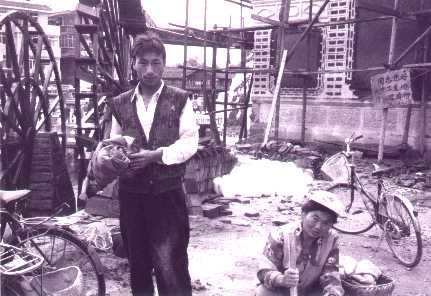The Center for U.S.-China Arts Exchange
tel (212) 280-4648 fax (212) 662-6346 email us_china_arts@yahoo.com
| board of directors | academic exchanges | cities project | the yunnan plan | leadership conference | newsletters | home |
The Cities Project

Cities East and West, A Comparative Study: Innovation and Tradition
In June 1997,
the Center for United States-China Arts Exchange completed an exchange
project funded by a grant from the Henry
Luce Foundation: Cities East and West, A Comparative Study: Innovation
and Tradition. It turned out to be the first exchange project of this
nature and scope, and uncovered a trove of challenging urban issues of
global concern. Chinese participants in the exchange expressed regret
that this project had not been undertaken earlier. They felt certain that
it would have influenced China's national planning policies during the
most massive urban change in China's history over the past decade.
The American
participants, on the other hand, felt stimulated by the issues and strategies
discussed, some of which they had never faced; while others offered insight
on their own urban experience at home. The enthusiasm for continued efforts
in this type of exchange was total in both countries.
The goals of this project were: (a) Understanding ancient Chinese urban
concepts as can still be perceived in selected cities, how these concepts
influence Chinese contemporary planning, and how they might contribute
to urban thinking in the West. (b) Examining current nationwide planning
policy in China as exemplified by these cities, which represent three
different stages of modernization, and evaluating how the modern American
experiences can contribute to the present Chinese long-term urban strategy,
covering the period of 1992-2010. (c) Considering if and how the current
Chinese experience, as well as that of the 1950's, may serve as object
lessons to current American urban thinking.
Specific concerns include the following: historic preservation and restoration;
redevelopment of old city areas; greenway and greenspace; zoning and density;
water supply and waste management; traffic and pollution; urban ecology
and quality of living; revitalization of arts and culture; local heritage
and tourism; engagement of the public in urban strategy; and regional
growth and coordination.
Cities Visited.
The American
Team visited Yangzhou, Changzhou, and Changshu. These are contiguous historic
urban centers of medium size along the Yangtze River between Shanghai
and Nanjing with a written history of at least twenty-five centuries.
The pre-visit conference was held in Beijing, where the team began its
orientation with visits to major historic sites illustrating principles
in ancient planning as well as Juer Hutong, the celebrated modern residential
district based on an adaptation of the traditional Chinese courtyard concept.
The post-visit conference was held in Shanghai, where the team also examined
the new economic development district, Pudong.
The Chinese
Team visited the Twin Cities (St. Paul and Minneapolis), New York City
(Manhattan only), Providence, Boston, Baltimore, and Washington, D.C.
The final conference was held in Washington, D.C.
Conferences
and Briefings
The Beijing
conference was designed as an introduction to the site visits in China.
It was attended by about 30 Chinese planners, architects, scholars and
administrators. The Chinese presentations included such topics as "Traditional
Urban Concepts in China" and "Traditional Concepts in Chinese Architecture."
Four Americans made presentations on the status of their own fields of
specialization in the U.S. today, namely, greenspace, livable communities,
urban redevelopment, and historic preservation.
The Shanghai
conference was designed as an exit-debriefing session . It was attended
by about 20 Chinese planners, architects, and professors. In addition
to the summation of the American Team's impressions, followed by discussions,
there were Chinese presentations on the history of urban development in
Shanghai, and on the two best preserved ancient cities in China, Pingyao
and Lijiang. Similar but more issue-oriented presentations and in-depth
discussions also took place during the visit to the three cities.
Chinese visitors
to the United States were briefed extensively by major local organizations
in each of the cities they visited. The Washington conference was hosted
by The Woodrow Wilson Center, and cosponsored by such national organizations
as the American Institute of Architects, the American Planning Association,
and the National Trust for Historic Preservation. It consisted of a half-day
roundtable discussion between the American and Chinese Teams, and a public
forum attended by about 75 invited professionals.